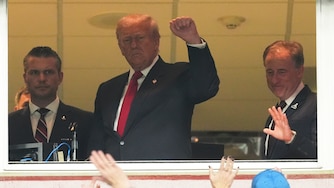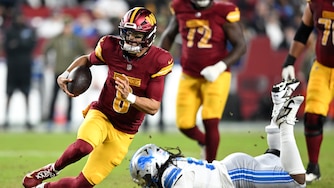There was a time when the Patterson Bowling Center, which opened in 1927, was considered state of the art, just as there was a time when even seemingly everyone from Baltimore — even Babe Ruth — played duckpin bowling.
But when Kristian Spannhake and his business partner Jesse Vann bought the Eastern Avenue building in early 2023, the bowling business, which had closed in December 2022, was crumbling, both literally and figuratively.
“We knew there was no future there with that particular operation,” Spannhake said of what was the country’s oldest continuously operating duckpin bowling alley.
Spannhake and Vann spent $2 million renovating the building, adding 15 apartments as well as a ground floor bar and a basement with two lanes for duckpin bowling. But the journey from conception to the opening of Patterson Pins this Thursday demonstrates Baltimore’s reverence for tradition.
Whether the new concept will appease fans of the old bowling center remains to be seen. While its brightly lit precursor looked like a portal to the 1940s, Patterson Pins is dark and futuristic. Where Patterson Bowling Center was BYOB, Patterson Pins sells $12 cocktails, listed on a menu designed to look like a video game case. (Budget-conscious drinkers can also find a $5 Kenwood lager on draught.)
Beverage director Shaun Stewart, who worked closely with Spannhake and Vann on designing it, said when he shows off the below-ground space, which features a 100-inch TV along with repurposed wooden church pews for seating, people often tell him it reminds them of their rich friend’s basement. “I’ll take that,” he said. “It kind of gives you that vibe.”
Read More
In addition to duckpin bowling, customers can choose from a slew of arcade-style games in a format Stewart says is a nod to Barcade, a combination bar and arcade in his native Philadelphia. One such game is Tapper, in which bartenders serve Budweiser to thirsty patrons. There’s a spot for your drink, too, said Stewart with a laugh.
Stewart, who also designed the bar program at Hampden Yards, in which Vann is a partner, called Patterson Pins a passion project for which he’s obsessed over every detail, down to the 3D-printed coasters designed to look like neon floppy discs. “I’ve sat in the space probably longer than I’ve been in my apartment for the last two months,” he said.
He’s anxious to see how Baltimoreans respond to the bar. “I go on Reddit every five days, and there’s not a lot of posts, which is great,” he said. One positive sign: He’s already gotten inquiries from parents looking to book the venue for kids’ birthdays and companies wanting to rent it out for their holiday parties.
While the developers initially planned to just have apartments in the space, with maybe a coffee shop on the ground floor, the desire for some form of duckpin bowling to remain became abundantly clear.
“When the community in Patterson Park told us that we could not lose Duckpin Bowling, we heard their call,” said City Council President Zeke Cohen in an emailed statement. Spannhaker said Cohen approached him soon after Patterson Bowling Center shut down. While he and Vann shot down the idea of a full-scale bowling alley, they were open to a concept that had some lanes, with a liquor license to be financially feasible.
One small problem: Local laws stipulate that, to get a new liquor license in that particular neighborhood, a business needs to serve food and also have a certain number of seats. The developers wanted to keep the operation small with no kitchen. State Del. Luke Clippinger and State Sen. President Bill Ferguson introduced legislation that would allow the business to have a liquor license — so long as it had duckpin bowling on-site.
While Patterson Pins won’t serve food beyond some snacks, they will encourage patrons to order grub from some of the surrounding eateries like Johnny Rad’s across the street, just as they did during the Patterson Bowling Center days. One thing they can’t bring from home, though, is alcohol.
The resulting project shows “we don’t have to choose between building more housing and preserving the funky, unique neighborhood culture that exists throughout our city,” Cohen said. “We can do both.”
Space constraints downsized plans from an initial four to eight lanes to the two now available. The pins are set using strings, not the aging Sherman pinsetter system that the Patterson Bowling Center used. Players get two balls per frame instead of the three you get in a traditional duckpin game.
Duckpin bowling, which uses smaller pins and balls than tenpin bowling, first came to Baltimore at a Howard Street bowling alley owned by two members of the Orioles. Laura Bowden, executive director of the National Duckpin Bowling Congress, said there’s evidence the sport originated in New England, where traditional tenpin bowling has existed “forever.” For its part, the National Duckpin Bowling Congress originated in 1927, the same year Patterson Bowling Center opened its doors. Founded in Washington, D.C., it is now based in Linthicum.
Bowden called it “bittersweet” to lose the historical Patterson Bowling Center, and regretted that the developers couldn’t use the old equipment, which they said was finicky and hard to repair. At the same time, she’s grateful the bowling still exists in some form. “Obviously anything that keeps people interested in the sport, we’re crazy about,” she said. “It keeps the game alive.”
Elsewhere around the globe, Bowden said, interest in duckpin bowling is growing. There are duckpin bowling alleys in the Philippines, she said, that use equipment from Maryland. And local fans of old-school duckpin bowling can head to venues like Parkville Bowling Lanes or Stoneleigh Lanes, the latter of which is owned by Ken Staub, who also ran the Patterson Bowling Center when it closed.
Staub said that when he walked away from Patterson Bowling Center, “I never looked back.” While he would have loved to stay in business, “it was impossible to make money during the pandemic.” He’s actually in the process of selling Stoneleigh Lanes (for a second time; an earlier buyer defaulted on their loan) and hopes to retire soon. As for the building’s new owners, “I wish them the best of luck,” he said.
Customers to Patterson Pins can revisit the past, though, by sharing 5-by-7-inch photos of themselves at the old Patterson Bowling Center through the years. They’ll be posted on the wall, in silver frames, a witness to the collective memories of the city.
This post has been updated.




Comments
Welcome to The Banner's subscriber-only commenting community. Please review our community guidelines.